Coral reefs are often called the rainforests of the sea—complex ecosystems that shelter a quarter of all marine life, feed millions of people, protect coastlines from storms, and attract travelers from around the world. Yet despite their importance, coral reefs are among the most threatened ecosystems on the planet. Rising sea temperatures, pollution, overfishing, and unsustainable tourism practices are pushing these vibrant habitats toward collapse. The loss of coral reefs would not only devastate marine biodiversity but also undermine the livelihoods of communities that depend on them.
This is where a new wave of regenerative travel comes in. Around the world, people are searching for ways to make their journeys more meaningful, to give back rather than simply consume. Instead of limiting themselves to sightseeing, divers, students, and travelers now have opportunities to volunteer in coral reef restoration abroad. These hands-on programs empower people to roll up their sleeves, don their dive gear, and help rebuild reefs directly. It’s conservation in action—tourism that strengthens rather than depletes.
In 2025, World Tourism Day shines a spotlight on this exact vision. Under the theme Tourism and Sustainable Transformation, it challenges the industry to become an agent of positive change by supporting education, livelihoods, and the health of our planet. For Perry Institute for Marine Science (PIMS) and its Reef Rescue Network (RRN), the timing couldn’t be better. Together, we’ve built one of the Caribbean’s most ambitious coral restoration movements, uniting dive operators, resorts, NGOs, and local communities around a shared mission: restore reefs and inspire ocean guardians.
One of the most exciting ways to join this movement is through the updated PADI Reef Rescue Diver Specialty Course. First launched in 2018 by coral restoration practitioner Hayley-Jo Carr, the course has already trained more than 400 recreational divers. These students didn’t just learn about coral biology—they actively contributed to restoring reef-building species across the Caribbean. With the 2025 updates, the program is now more accessible, more scientific, and more impactful than ever before.
The Reef Rescue Diver course blends education and action. Participants learn the science behind coral ecosystems and the threats they face. They gain hands-on skills in nursery maintenance, coral planting, and monitoring. Most importantly, they make a tangible difference: every coral planted is a step toward reviving endangered reefs and strengthening the communities that depend on them. For travelers eager to volunteer in coral reef restoration abroad, this program offers the perfect gateway.
But this is about more than individual dives. It’s about transforming tourism into a regenerative force. By engaging both residents and visitors in restoration activities, PIMS and the Reef Rescue Network are fostering environmental stewardship, creating sustainable livelihoods, and bolstering the blue economy. Tourism doesn’t have to be extractive—it can heal, empower, and sustain.
As you explore how to get involved, remember this: making a difference often starts with a single dive. Whether you’re an experienced diver seeking new purpose or a traveler drawn to eco-tourism, the updated Reef Rescue Diver course is your chance to step into action. The ocean doesn’t just need tourists—it needs guardians.
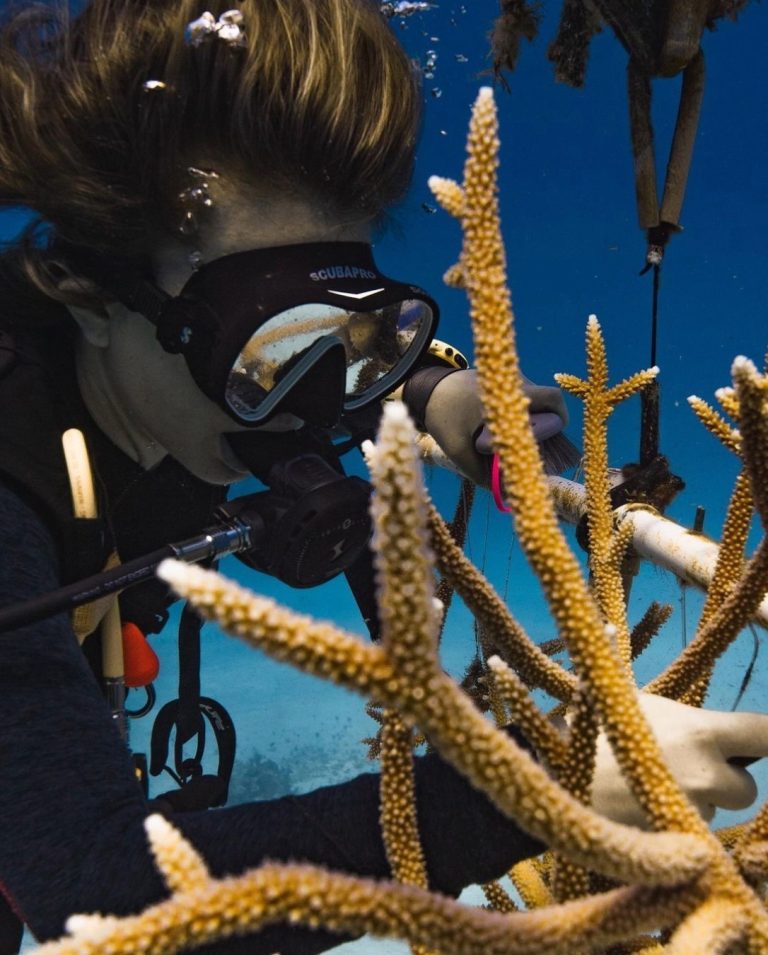
Why Volunteer in Coral Reef Restoration Abroad?
Coral reefs are more than breathtaking natural wonders—they are lifelines for people and the planet. These underwater ecosystems provide food, protect shorelines, support global biodiversity, and draw millions of tourists each year, fueling local economies. Yet reefs face mounting threats: rising sea temperatures, pollution, disease, and unsustainable human practices are placing them on the brink of collapse. Without urgent action, both marine life and the coastal communities that depend on reefs for survival risk losing an irreplaceable resource.
This is where volunteers step in. Choosing to volunteer in coral reef restoration abroad isn’t just a unique travel experience—it’s an opportunity to be part of the solution. Instead of being a passive observer of reef decline, you can actively contribute to their recovery. By working alongside scientists, dive operators, and local communities, volunteers help rebuild reef structure, enhance genetic diversity, and provide critical habitat for fish, invertebrates, and other marine species.
For travelers who want to give back, coral restoration offers a hands-on way to combine conservation and adventure. Whether maintaining underwater coral nurseries, planting coral fragments on degraded reefs, or monitoring reef health, every task contributes to safeguarding these ecosystems for future generations. These efforts are essential because they support reef-building species, many of which are now endangered, and help to stabilize ecosystems that sustain coastal livelihoods.
The benefits of volunteering go beyond the reefs themselves. Programs like the Reef Rescue Network (RRN) demonstrate how conservation and tourism can align to strengthen communities. By engaging visitors in restoration activities, the RRN fosters environmental stewardship and supports sustainable livelihoods. Many of the PADI Reef Rescue Diver Instructors trained through the program are women, advancing careers while contributing to the local tourism economy. Volunteering abroad doesn’t just protect corals—it uplifts people by creating jobs, skills, and resilience.
On a broader scale, reef restoration is directly tied to the blue economy. Healthy reefs attract divers, snorkelers, and eco-conscious travelers, generating revenue that sustains businesses, resorts, and tour operators. By volunteering, you’re not only helping to restore ecosystems—you’re also supporting regenerative tourism that ensures communities can thrive without depleting the very resources they depend on.
There’s also a personal transformation that comes with volunteering. Many participants describe a profound shift in perspective after planting their first coral fragment or maintaining a nursery teeming with young corals. The experience fosters a deep sense of connection to the ocean and to global conservation efforts. It turns a holiday into a legacy—proof that tourism can restore, not just consume.
In short, to volunteer in coral reef restoration abroad is to join a global movement of ocean guardians. It’s about diving with purpose, protecting the “rainforests of the sea,” and ensuring that future generations inherit thriving reefs instead of barren seascapes. For anyone seeking meaningful travel that blends adventure, science, and impact, volunteering in coral reef restoration is one of the most powerful ways to make a difference.
The Reef Rescue Diver Specialty Course: Updated for 2025
For travelers who want to move beyond passive eco-tourism and truly make a difference, the Reef Rescue Diver Specialty Course offers a direct pathway to action. This flagship program has already trained and certified more than 400 recreational divers across the Caribbean. Each participant didn’t just learn about reefs—they actively contributed to restoring them, becoming part of a growing global network of ocean guardians. Now, in 2025, the course has been completely redesigned to make volunteering in coral reef restoration abroad more accessible, impactful, and aligned with the latest science.
At its core, the Reef Rescue Diver course blends education with action. Students begin by learning the fundamentals of coral reef ecosystems—the intricate relationships that sustain them, the mounting threats they face, and the steps humans can take to protect them. But this is no ordinary classroom experience. After completing the theory portion, divers put their knowledge into practice underwater: maintaining coral nurseries, cleaning structures, planting coral fragments, and even working with advanced restoration techniques like microfragmentation. These tasks directly contribute to rebuilding reef structure, enhancing biodiversity, and giving critically endangered species a second chance.
What’s New in 2025?
The updated course builds on years of experience and incorporates global best practices in reef restoration:
Full Digital Learning: Students can now complete the theory component online, at their own pace, before arriving at a partner location. This flexibility makes it easier than ever to prepare for your restoration dives abroad.
Up-to-Date Reef Protection Guidelines: The student manual, co-authored by Lily Jane and Hayley-Jo Carr of the Perry Institute for Marine Science, has been refreshed to include the newest science-backed strategies for reducing threats to coral reefs, ensuring every diver is equipped with current knowledge.
Latest Scientific Techniques: The course now covers innovative restoration methods, from microfragmentation to new nursery designs and materials, reflecting the cutting edge of coral science.
Refreshed Knowledge Review: Assessments have been updated to match the revised manual, reinforcing understanding and preparing students for real-world application.
Renewed PADI Instructor Guide (2025–2026): Instructors now have enhanced tools and teaching guides, freeing them to focus on in-water training and sharing local knowledge about restoration sites.
These updates mean that when you volunteer in coral reef restoration abroad through the Reef Rescue Diver course, you’re not only learning—you’re practicing the same techniques used by leading marine scientists.
Why This Course Matters
Every diver who completes the Reef Rescue Diver course helps fund and expand restoration projects across the Caribbean. Proceeds from the student manual directly support coral nurseries and planting initiatives, ensuring that your training contributes to real-world impact. In addition, the program has already trained over 100 PADI Reef Rescue Diver Instructors, many of them women, advancing local careers and strengthening community-based tourism economies. By choosing this course, volunteers become part of a regenerative tourism model—one where travel protects and restores rather than consumes.
In short, the updated Reef Rescue Diver Specialty Course is more than a certification. It’s an invitation to dive with purpose, to blend travel with impact, and to join a global movement of individuals determined to restore the ocean’s most vital ecosystems. For anyone ready to volunteer in coral reef restoration abroad, 2025 is the perfect year to start.
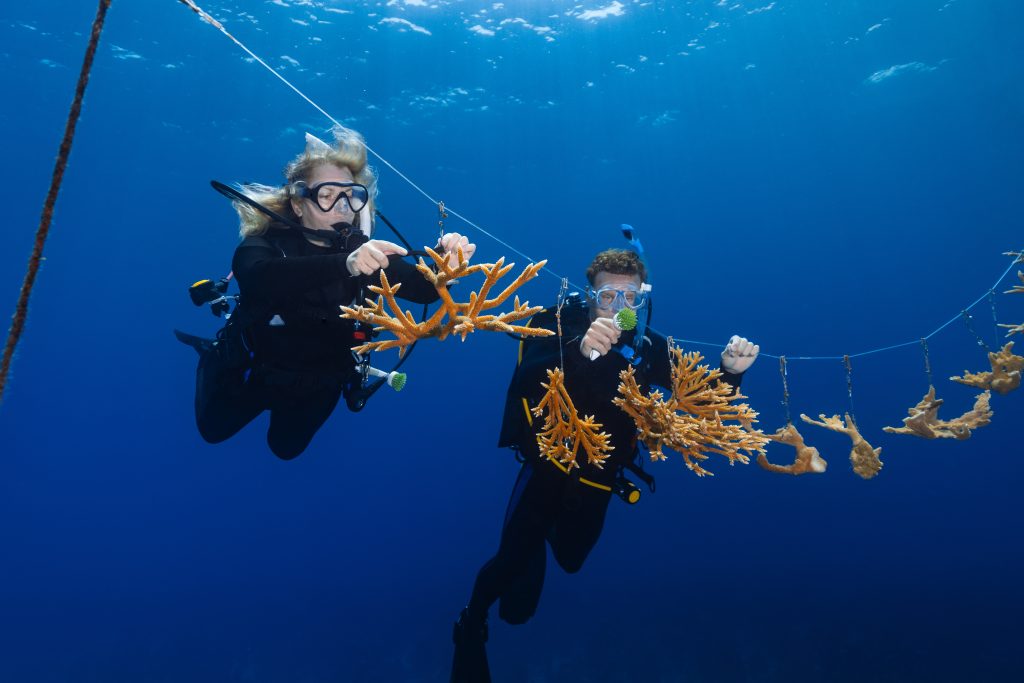
Building Sustainable Futures Through Tourism
Tourism is one of the world’s most powerful economic engines, employing one in every ten people globally and sustaining hundreds of millions more. In the Caribbean, where pristine waters and vibrant reefs attract visitors from every corner of the globe, tourism isn’t just a luxury industry—it’s the foundation of many local economies. Yet, the same sector that depends on healthy coral reefs is also vulnerable to their decline. Rising sea temperatures, pollution, and unsustainable practices put both the environment and tourism livelihoods at risk. The challenge, then, is clear: how do we make tourism not only sustainable but regenerative?
The answer lies in aligning travel with conservation. Programs like the Reef Rescue Network (RRN) show that it’s possible to transform tourism into a driver of ecosystem recovery. By inviting visitors to volunteer in coral reef restoration abroad, the RRN connects the thrill of travel with the urgency of conservation. Divers don’t just observe coral reefs—they help restore them, turning vacations into opportunities for stewardship. This model not only protects ecosystems but also ensures that the communities who depend on reefs for food, jobs, and protection from storms continue to thrive.
One of the most powerful outcomes of this approach is the creation of sustainable livelihoods. Through the Reef Rescue Diver Specialty Course, PIMS and the RRN have trained and certified over 100 PADI Reef Rescue Diver Instructors, many of them women. These instructors now lead restoration dives, guide eco-conscious tourists, and share their local knowledge, advancing careers while strengthening the blue economy. Tourism dollars are no longer flowing in and out without lasting benefit—they’re being reinvested in people and ecosystems.
When tourists choose to engage in activities like volunteer coral reef conservation programs, they also support a ripple effect of benefits. Healthier reefs attract more marine life, which in turn attracts more visitors. Resorts and dive operators that participate in coral restoration not only enhance their appeal to eco-travelers but also protect the very resources their businesses rely on. This creates a cycle of regeneration: restoration projects sustain reefs, reefs sustain tourism, and tourism sustains communities.
Importantly, this isn’t just about divers. Regenerative tourism can engage people at many levels. From local youth learning restoration skills to international volunteers traveling abroad for hands-on experience, every participant helps scale up the impact. These efforts encourage stronger governance, community involvement, and cross-sector collaboration between NGOs, resorts, and governments.
For travelers, the opportunity to volunteer in coral reef restoration abroad provides more than just a meaningful holiday—it’s a chance to leave a positive legacy. Instead of being a visitor who consumes resources, you become part of a global movement working to restore them. You contribute to building a sustainable future where ecosystems and economies are resilient, and where the ocean is healthier because of tourism, not in spite of it.
In the end, building sustainable futures through tourism isn’t just a lofty goal—it’s a lived reality being shaped today across the Caribbean. By diving in, planting corals, and supporting regenerative travel initiatives, volunteers and visitors alike are proving that tourism can heal, empower, and protect.
How to Volunteer in Coral Reef Restoration Abroad: Step-by-Step
Making a difference in the ocean doesn’t require a lifetime of scientific training—it starts with one dive. The Reef Rescue Diver Specialty Course, updated in 2025, makes it possible for anyone with a passion for the sea to volunteer in coral reef restoration abroad and directly contribute to the survival of these fragile ecosystems. Whether you’re a recreational diver seeking more purpose in your travels or an eco-tourist looking for hands-on conservation opportunities, here’s how you can get involved step by step.
Step 1: Download the Reef Rescue Diver Manual
The journey begins with knowledge. For $35.99, you can purchase and download the updated Reef Rescue Diver Manual through the Perry Institute for Marine Science’s online store. This digital resource allows you to complete the theory portion of the course at your own pace, from anywhere in the world. The manual covers the fundamentals of coral reef ecosystems, the threats they face, and the latest best practices in restoration. Importantly, your purchase directly funds coral restoration projects across the Caribbean—meaning your impact begins before you even enter the water.
Step 2: Choose Your Reef Rescue Network Partner Location
Once you’re prepared, it’s time to choose where your restoration adventure will take place. The Reef Rescue Network (RRN) unites dive shops, resorts, tour operators, and NGOs across the Caribbean to create a regional movement for reef recovery. Using the interactive RRN map, you can select from partner locations in The Bahamas and beyond, each offering its own unique coral nurseries and restoration projects. Whether you dream of diving in the turquoise waters of Eleuthera, exploring reefs near Abaco, or working alongside local communities in Nassau, your choice connects you to real, on-the-ground conservation.
Step 3: Complete Your Training Dives and Plant Corals
The highlight of the program comes when you put your training into action. Under the guidance of certified Reef Rescue Diver Instructors, you’ll practice hands-on restoration skills—cleaning nursery structures, planting coral fragments, and learning advanced techniques like microfragmentation. Every coral you help plant strengthens reef structure, boosts biodiversity, and provides habitat for important fisheries species. This is where volunteering transforms from theory into tangible results, as you literally leave the ocean healthier than you found it.
Step 4: Join a Global Network of Ocean Guardians
Completing the course makes you part of a growing community of more than 400 divers who have already supported reef restoration through PIMS and the RRN. As a certified Reef Rescue Diver, you carry the skills and knowledge to continue contributing wherever your travels take you. The certificate is more than a credential—it’s a commitment to stewardship, one that ties you into a global movement of eco-tourists, conservationists, and communities determined to restore reefs.
Why This Step-by-Step Process Matters
Following this pathway ensures that your efforts are scientifically sound, locally relevant, and globally impactful. When you volunteer in coral reef restoration abroad through the Reef Rescue Diver program, you’re not just a visitor—you’re part of a regenerative tourism model. Each step, from purchasing the manual to planting corals in the field, connects your travel experience to the long-term health of marine ecosystems and the livelihoods that depend on them.
Dive in. Make a difference. The ocean doesn’t just need tourists—it needs guardians.
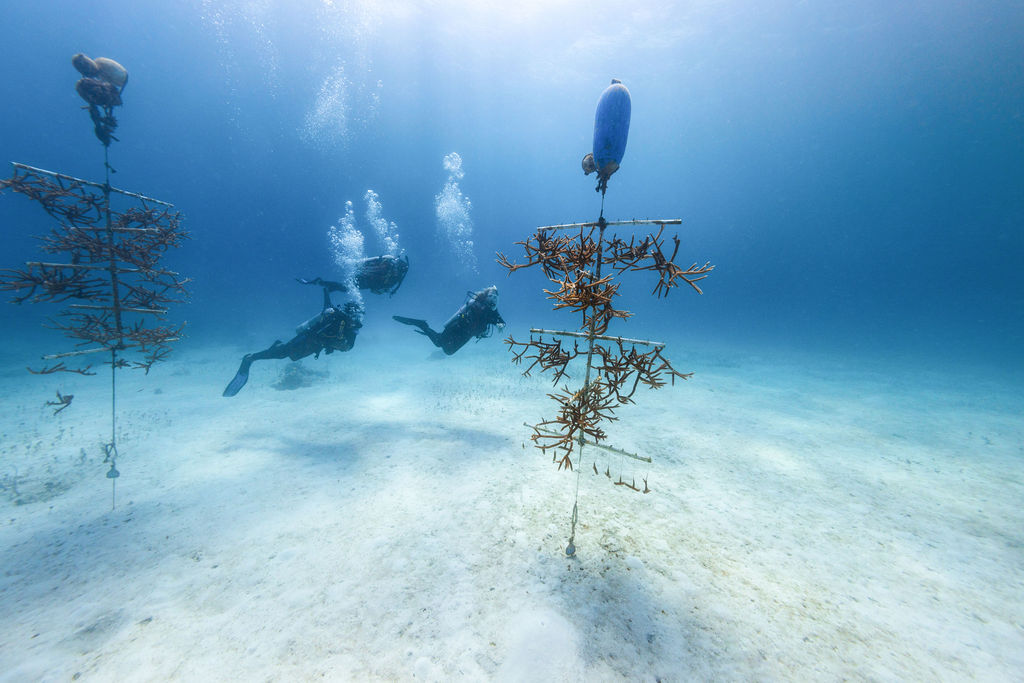
Frequently Asked Questions (FAQs)
Choosing to volunteer in coral reef restoration abroad is an exciting step, but it often comes with questions. Below are answers to some of the most common queries travelers have before joining the Reef Rescue Diver Specialty Course and other restoration experiences.
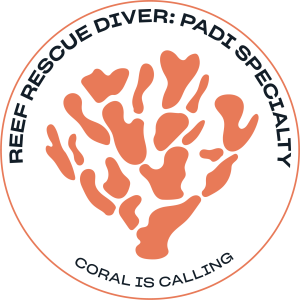 1. Do I need to be scuba certified to volunteer in coral reef restoration abroad?
1. Do I need to be scuba certified to volunteer in coral reef restoration abroad?
Yes. Because restoration work involves diving to nurseries and reef sites, participants need to be certified as PADI Open Water Divers or equivalent. This ensures you have the basic skills and confidence to dive safely while learning restoration techniques. If you’re not certified yet, you can complete your entry-level training first, then enroll in the Reef Rescue Diver course during your trip.
2. What exactly will I be doing during the Reef Rescue Diver course?
The course blends education with action. After completing the digital manual at home, you’ll work with trained instructors to practice hands-on skills underwater. Tasks include cleaning coral nursery structures, planting coral fragments, and learning advanced methods such as microfragmentation. Each activity contributes to real restoration projects managed by the Reef Rescue Network (RRN). By the end, you’ll know how to help protect reefs and will have directly contributed to their recovery.
3. Where are the best places to volunteer in coral reef restoration abroad?
The Caribbean is one of the most dynamic regions for coral restoration tourism. Through the RRN, you can choose from partner locations across The Bahamas and beyond. Each site offers unique opportunities to engage with local communities, experience diverse marine environments, and witness restoration firsthand. From the turquoise waters of Eleuthera to bustling projects in Nassau, your choice allows you to connect travel with conservation.
4. How much does it cost to join?
The starting point is purchasing the updated Reef Rescue Diver Manual for $35.99. This fee not only gives you access to the digital course materials but also directly supports coral restoration projects throughout the Caribbean. Additional costs may include dive training sessions, gear rentals, and travel expenses depending on your chosen partner location. While costs vary, volunteers consistently describe the experience as priceless because of the impact they make.
5. Can beginners or non-scientists participate?
Absolutely. The Reef Rescue Diver course is designed for recreational divers, not just scientists. You don’t need a background in marine biology to contribute meaningfully. The program provides all the training you need, blending accessible education with guided hands-on practice. By the end of your course, you’ll have the confidence and skills to continue supporting restoration efforts whenever you travel.
6. How does my participation make a difference?
Every coral you plant, every nursery you maintain, and every manual you purchase contributes to restoring ecosystems that are vital for biodiversity and coastal communities. Your efforts support endangered reef-building species, strengthen local economies that rely on tourism, and build resilience against climate change. By choosing to volunteer in coral reef restoration abroad, you’re part of a global movement proving that tourism can heal rather than harm.
Why Choose Reef Rescue Diver with PIMS?
When it comes to opportunities to volunteer in coral reef restoration abroad, there are many programs to choose from. But not all initiatives offer the same level of scientific credibility, community impact, and long-term sustainability. That’s what makes the Reef Rescue Diver Specialty Course, created by the Perry Institute for Marine Science (PIMS) and delivered through the Reef Rescue Network (RRN), a unique and trusted option for travelers who want their time abroad to truly matter.
Backed by Over 50 Years of Science and Conservation
PIMS has been at the forefront of marine research and conservation in The Bahamas and Caribbean for more than five decades. The organization has earned an international reputation for combining cutting-edge science with community-driven solutions. When you volunteer through Reef Rescue Diver, you’re not just planting corals—you’re contributing to restoration projects shaped by the latest research and guided by globally recognized best practices. This ensures your efforts have lasting ecological impact, not just symbolic value.
A Regional Network with Global Reach
The Reef Rescue Network is the Caribbean’s largest coral restoration alliance, uniting dive operators, resorts, NGOs, and local communities across multiple islands. This scale matters. It means that your participation is part of a coordinated, regional effort that magnifies individual contributions. Whether you volunteer at a nursery in Eleuthera, Nassau, or another partner site, you’re helping to grow a movement that stretches across the Caribbean and connects with international partners working on reef recovery.
Training that Empowers, Not Just Informs
Many eco-tourism programs offer volunteers the chance to observe conservation. Reef Rescue Diver goes further—it equips you with knowledge and skills you can carry forward. The course blends digital learning with hands-on training so that by the time you arrive at your chosen destination, you’re ready to dive straight into restoration work. With updated modules covering coral biology, threats to reefs, and restoration methods like microfragmentation, the program ensures every participant contributes effectively.
Supporting Sustainable Livelihoods
Volunteering abroad is not only about helping ecosystems; it’s also about supporting people. Through the RRN, over 100 PADI Reef Rescue Diver Instructors have already been trained and certified, many of them women. These instructors earn livelihoods by teaching, guiding dives, and leading restoration projects, strengthening local economies tied to tourism. When you take part in the program, your fees and participation directly support these careers and the communities that depend on them.
Proven Impact, Meaningful Legacy
Every step of the Reef Rescue Diver course—from downloading the manual to planting corals underwater—contributes directly to the survival of reef-building species. Funds raised through course materials are reinvested in restoration, ensuring that your involvement has both immediate and long-term effects. Unlike one-off experiences, this course is part of a regenerative tourism model that proves travel can restore, not just consume.
The Clear Choice
If you’re looking to volunteer in coral reef restoration abroad in a way that combines credibility, scale, and community benefit, Reef Rescue Diver with PIMS stands out. It’s not just a dive course; it’s an entry into a global network of ocean guardians committed to building a sustainable future. By choosing this program, you align your passion for travel with science-backed solutions and ensure that your time in the water leaves the ocean healthier than you found it
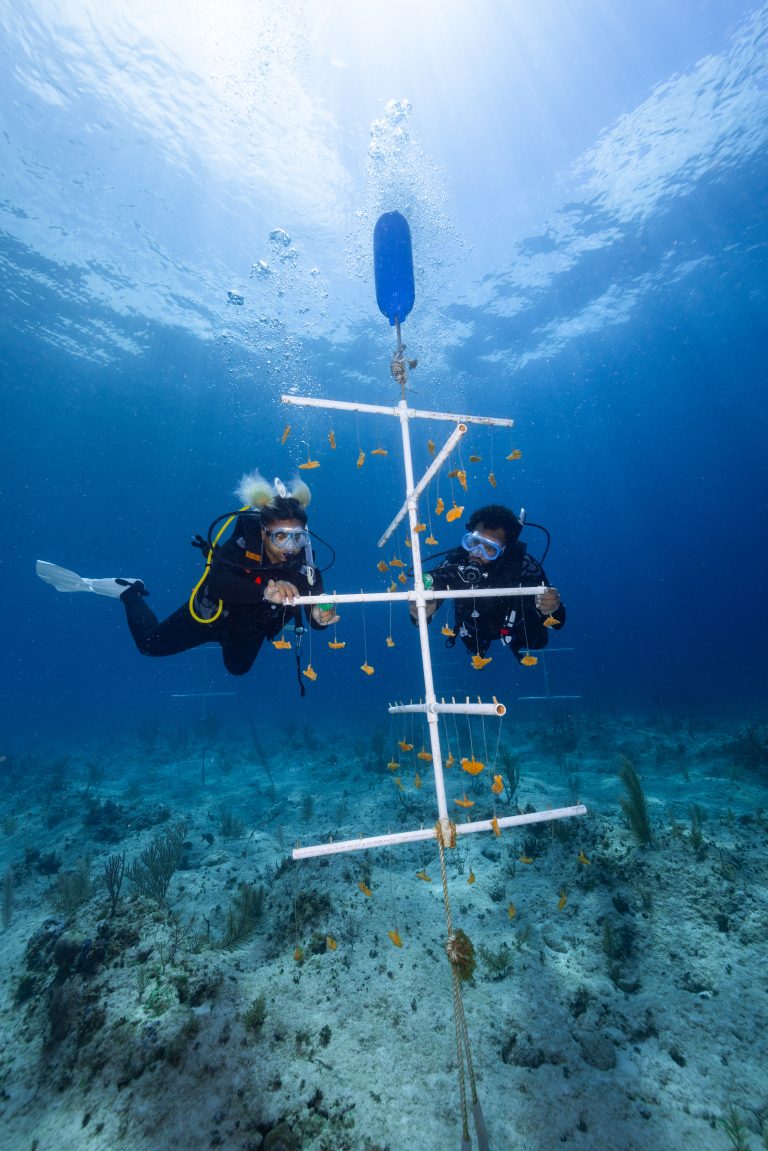
Call to Action: Dive In and Make a Difference
The ocean doesn’t just need tourists—it needs guardians. If you’ve ever dreamed of giving back to the sea that gives us so much, now is your chance. By enrolling in the updated Reef Rescue Diver Specialty Course, you can volunteer in coral reef restoration abroad and directly support the survival of one of the planet’s most vital ecosystems.
Getting started is simple:
-
Download the Reef Rescue Diver Manual for just $35.99. Your purchase immediately funds coral restoration projects across the Caribbean.
-
Choose your Reef Rescue Network partner location from our interactive map and plan your trip to a destination where your skills will make the greatest impact.
-
Dive into action. Complete your training dives, help maintain coral nurseries, plant fragments, and leave the ocean healthier than you found it.
Every coral you plant is more than a fragment—it’s hope for future generations. Every dive you take is part of a global movement proving that tourism can heal, not harm.
Are you ready to transform your travels into lasting impact? Join us and volunteer in coral reef restoration abroad today.
